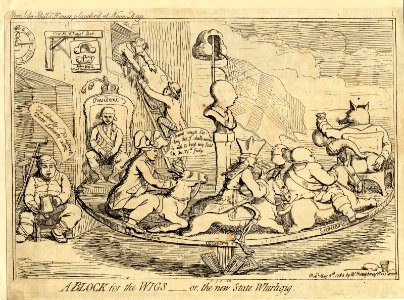A merry-go-round in violent action, ministers seated on the horses, &c, fixed on a circular platform which is supported on a short central beam. This beam is held in place by three blocks or wedges inscribed "treasury", "navy", "army". In the centre of the platform, on a tall pedestal, a continuation of the supporting beam, is a bust of the king in profile, the features blank, the head bald, a bob-wig being supported on a pole above his head; from this pole floats a ragged british flag. The king, the centre of the structure, is represented as a wig-block, or a block for the whigs. The foremost figure on the merry-go-round on the extreme right is fox, seated in a chair, in back view, with a fox's head and brush; he holds up a large money-bag in his left hand, looking over his shoulder at his followers with a jeering expression; his large brush flies out behind him. Behind him, riding a galloping horse whose legs are cut off at the knees, is north, his wig flying from his head with the violence of the motion. [a great meeting of the electors of westminster on 6 march was repeatedly interrupted by a heckler asking "how long has lord north been a whig?" 'remembrancer', 1783, i, 211] behind him is burke, on a similar horse, dressed as a jesuit, wearing a large biretta as in bmsat 6205. He is in profile to the right, wearing spectacles, and fading from a book he holds open before him, inscribed "sublime & beautiful" (in allusion to his "philosophical enquiry. . ", 1756). His leg is that of a skeleton, probably to indicate the character of his policy of economical reform. Behind burke is keppel, in naval uniform, riding on an ass with its legs folded beneath it. He is saying "dam'd rough sailing this, i shall never be able to keep my seat till the 27th july", another allusion to the battle of ushant. Cf. Bmsat 5992, &c. Behind keppel, seated on a throne inscribed "president", full-face and smiling, is a man with bare knees, short turban, breeches, and tartan stockings. From the crown which decorates the back of his throne hang two large thistles. He wears the ribbon of an order, and represents scottish influence personified possibly in bute, probably in lord stormont, who was president of the privy council in the coalition ministry and k. T. The rim of the merry-go-round opposite keppel, burke, and north respectively is inscribed "balaam, œconomy, secretary. "
the round-about is outside an inn, part of which appears on the left. On the sign-board, which swings from a beam inscribed "crown & royal bob", is a crown, above which is a bob-wig like that suspended above the king's head. Beneath is written "john bull good entertainment". A clock-face on the wall points to 12. 15. From an upper window a man reaches out to take a large bundle which is being handed to him by a man on a ladder. Above, on the upper margin of the print, is inscribed "poor john bull's house plunder'd at noon day". On a low stool outside the inn sits a lame man, with swathed legs and closed eyes, his crutches beside him; he holds a pipe in one hand, a tankard in the other. He sings, "tis liberty tis liberty, dear liberty alone", signifying how easily john bull is plundered and bemused by talk of liberty. One of many satires on the coalition, see bmsat 6176-9, &c. 5 may 1783
etching. Date: 1783. Dimensions: Height: 250 mm; Width: 340 mm. Medium: paper. Depicted People: Edmund Burke. Collection: British Museum. A block for the wigs - or, the new state whirligig. (BM 1851,0901.142 1)
Loading...
